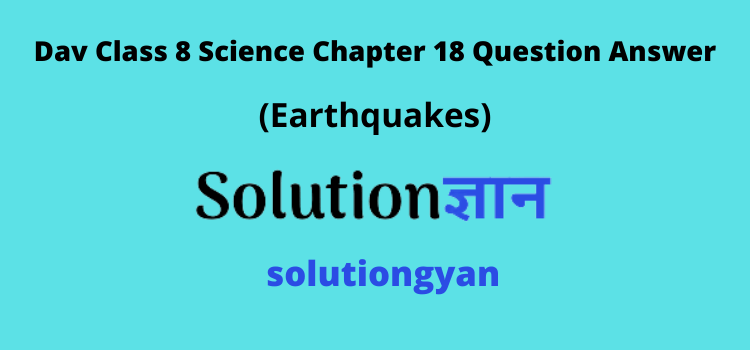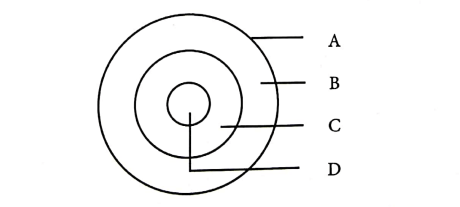DAV Class 8 Science Chapter 18 Solutions Earthquakes of The Living World Science Book guides you with the answers to the questions given in the textbook. Class 8 is an important phase of the student’s life as they are introduced to many new concepts that are essential to set strong basics foundation for the topics to be taught in Class 9.
While solving chapter 18 of Science textbook, students often face several doubts and eventually get confused. To help DAV Class 8 students clear all their doubts instantly, Class 8 Science Chapter 18 question answer Earthquakes come as a great resource. Here, the detailed Solutions for Class 8 Science Chapter 18 of Science book are given below.

These DAV Class 8 Science Chapter 18 Solutions Earthquakes will help you in scoring good marks as they cover important concepts in different patterns like fill in the blanks, State True or False for the following statements, tick the correct option, Answer the following questions in brief and Answer the following questions.
Dav Class 8 Science Chapter 18 Earthquakes Question Answer
DAV Class 8 Science chapter 18 question answer Earthquakes, is given below. Here DAV Class 8 Science Chapter 18 solutions is provided with great explanation.
Highlights
- Fill in the blanks
- State True or False
- Tick the correct option
- Answer the following questions in brief
- Answer the following questions
Dav Class 8 Science Chapter 18 Question Answer Earthquakes of The Living World Science Book is the best study material for those students who are finding difficulties in preparing for their science exams. Students can also prepare their notes and other class assignments for free.
DAV Class 8 Science Chapter 18 Solutions
A. Fill in the blanks.
1. ___________ are the smaller earthquakes that happen in the same place before the main quake follows.
2. The ‘high wall sea waves’, caused by underwater earthquakes, are called ___________.
3. Earthquake is caused by a disturbance deep inside the ___________ of earth.
4. The waves, associated with the tremors caused by earthquakes, are known as ___________ waves.
5. Geologists, call the point of origin of earthquakes, as its ___________.
6. Destructive energy of an earthquake is measured on the ___________ scale.
Answer: (1) Foreshock (2) Tsunami (3) crust (4) seismic (5) focus (6) Richter.
B. State True or False for the following statements.
1. It is now possible to give exact predictions about the earthquakes.
2. Earthquakes, beneath the ocean floor, can generate huge tidal waves.
3. When the plates of the earth slide past each other, the energy released gives rise to waves known as seismic waves.
4. Richter Scale is a simple linear scale.
5. An earthquake, of magnitude 2.5 on Richter Scale, cannot be recorded on a seismometer.
6. In highly seismic areas, it is better to have house made from mud or timber, than those made by using heavy construction materials.
Answer: (1) False (2) True (3) True (4) False (5) False (6) True.
C. Tick the correct option.
1. The minor quake, that might occur before the main earthquake, is known as a-
Answer: foreshock
2. A natural phenomenon, whose triggering is not associated with an earthquake, is-
Answer: flood
3. Earthquakes occur when there is a sudden release of stored up energy in earth’s-
Answer: crust
4. The various layers of earth are marked as A, B, C and D as shown in the given figure.

The correct labelling, of these layers A, B, C and D of earth, is-
Answer: A. crust, B. mantle, C. outer core, D. inner core
5. The epicenter of an earthquake is-
Answer: on the surface of earth
6. The magnitudes of two earthquakes, A and B, on the Richter Scale, were 7 and 5, respectively. The strength of-
Answer: earthquake A is 100 times that of earthquake B.
D. Answer the following questions in brief.
1. What is an earthquake?
Answer: An earthquake is a sudden tremor, or movement of earth’s crust, which lasts for a very short time.
2. State any three of the ‘damaging effects’ of an earthquake.
Answer: Three ‘damaging effects’ of an earthquake are:
- Earthquakes can cause damage to the buildings, bridges, dams.
- Earthquakes, in many cases, may cause great loss of life.
- Earthquakes can also cause floods and landslides.
3. Explain the phenomenon of production of shock waves.
Answer: When the plates of the earth’s crust slide past each other, they may get stuck at their edges due to friction. When the stress on the edges overcomes this friction, a large amount of energy is released in the form of waves. These waves are known as seismic or shock waves.
4. In the context of an earthquake, which of the two points: the focus or the epicenter, is deep under the ground?
Answer: In the context of an earthquake focus is the points which is deep under the ground.
5. Name the scale used for measuring the strength of an earthquake. Write the likely magnitude of (a) a mild earthquake (b) a highly destructive earthquake on this scale.
Answer: Richter Scale is used for measuring the strength of an earthquake.
(a) Answer: The likely magnitude of a mild earthquake varies from 2.5 – 4.5 on Richter scale.
(b) Answer: The likely magnitude of a highly destructive earthquake is 8.0 and above on Richter scale.
6. An earthquake measures 3 on Richter Scale.
(a) Would it be recorded on the seismometer?
Answer: Yes, it will be recorded on the seismometer.
(b) Is it likely to cause much damage?
Answer: No, it is a very mild earthquake. Might not be felt by many people.
E. Answer the following questions.
1. Explain, in brief, the cause of an earthquake.
Answer: Earthquakes are caused by disturbances deep down inside the uppermost layer of the earth. The outermost layer of the earth is not in a ‘single piece’; it is broken into a number of plates, known as tectonic plates. These plates are moving around very slowly- just a few millimetres every year. The movements of these plates cause changes on the surface of the earth which may cause an earthquake.
2. Where are the earthquakes more likely to occur?
Answer: Over 80 per cent of earthquakes occur around the edges of the Pacific Ocean, an area known as the ‘Ring of Fire’; this where the Pacific plate is being subducted beneath the surrounding plates. The Ring of Fire is the most seismically and volcanically active zone in the world.
3. Mr. Sarthak is the head of a construction company. He got a contract to design and build a housing complex in an area which was under the ‘seismic zone’. State the main precautions which Mr. Sarthak’s company should take so that houses, built by it, are durable.
Answer: All the buildings in seismic zones need be designed so that they can withstand major tremors. It is advisable to make the structure simple so that it is ‘Quake Safe’. Since some buildings may catch fire (due to an earthquake), it is necessary that all the buildings (specially the tall ones) have their firefighting equipment in order.
4. State the precautions, that one should take for protection during an earthquake if one is (a) inside the house (b) outdoors.
Answer: Protection during an earthquake if a person present inside the house:
- Take shelter under a table and stay there till the shaking stops.
- Stay away from tall and heavy objects that may fall on you.
- Do not get up if you are in a bed. Protect your head with pillows.
- Stay indoor until shaking stops and it is safe to move outside.
(b) Protection during an earthquake if a person caught outside in the open:
- Find a clear spot, away from buildings, trees, bridges and overhead power lines.
- Do not come out if sitting in a moving vehicle. Drive slowly to a clear spot and stay inside. Come out only when the tremors stop.
5. State the main precautions that can be taken to minimise the effect of an earthquake.
Answer: The main precautions that can be taken to minimise the effect of an earthquake are:
- Help the injured ones.
- Use telephones only in emergency.
- Beware of possible tsunami if you live in coastal area.
- Disaster management supplies like flashlights, first aid box, etc. should be available on hand.
